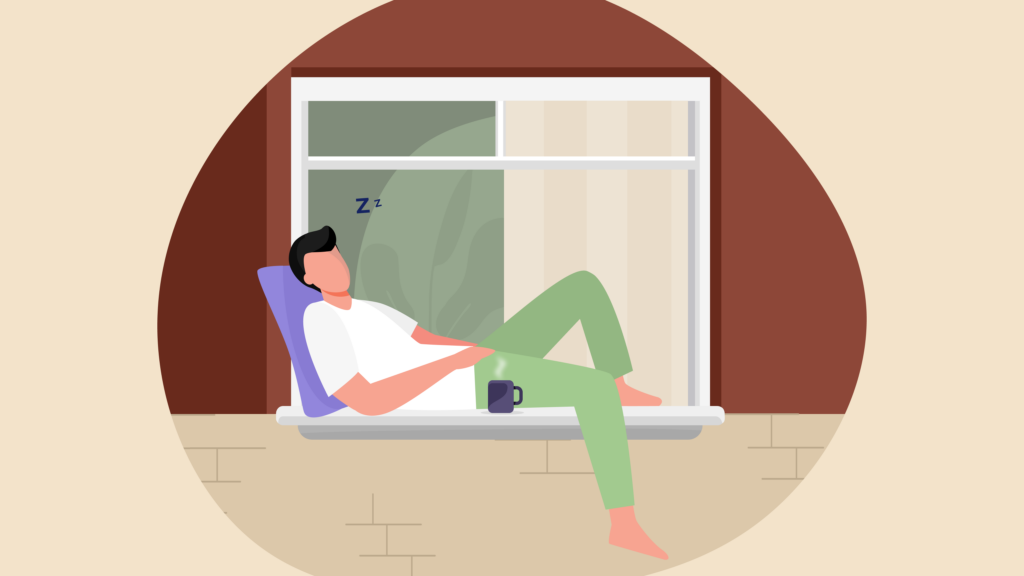In this article, we’ll look at the benefits of power naps for your mental well-being and give you some tips on how to integrate power naps into your everyday life.

It’s recommended that adults up to the age of 64, need 7-9 hours of sleep per night. However, the latest research has shown that:
“Feeling tired makes already existing problems worse – plus, tiredness can trigger problems that weren’t there in the first place,” says psychologist Paul Hessels. “With less energy, it becomes harder and harder to control your thoughts. So if you tend to ruminate, this gets worse and can in turn lead to less sleep.”
But lack of sleep doesn’t just affect your wellbeing, it can also have a negative impact on your relationships, as you tend to be more irritable and more emotional without sufficient sleep.
If you find yourself constantly checking the clock and worrying that you won’t get the ideal night’s sleep, this can be counterintuitive. “The worst thing about sleep problems is the stress that comes from not having a good night’s sleep and not being able to fall asleep. Because sleep means getting into a state of rest. Stress is the opposite of that. So if we want to fall asleep at all costs, we make it harder for ourselves” says Paul Hessels.
Accepting your sleep is a better strategy than stressing about it. Instead, think about ways in which you can improve your sleep for the next night. Alternatively, you can practice power napping (more on that later!).
Have you ever wondered how we came to our conventional, modern way of sleeping? Interestingly, our modern day sleeping habits have evolved due to complex economic and social changes. In fact, it has only been in the last 150 years that people have had a conventional night’s sleep with little or no afternoon naps. This came about as a result of industrialisation, when our sleep rhythm was adapted to align with work shifts. Throughout the preindustrial world, people slept biphasically, spreading two main sleep times and a nap over 24 hours. In the Middle Ages, people went to bed when the sun set, then stayed awake for a few hours after midnight, and then slept for several hours up until the morning.
Sleeping during the day is only for lazy people, right? Far from it! Studies show that early afternoon power naps improve cognitive performance and increase productivity. This is especially evident when compared to people who do not nap during the day.
From a long-term perspective, power napping also has many benefits. A long-term study from Greece found that those who napped for half an hour at least three times a week had a 37% lower risk of heart attack because stress hormones were reduced during sleep.
✅ Improves cognitive performance
✅ Have a positive effect on creativity
✅ Reduce stress
✅ Improve concentration
✅ Lower blood pressure
✅ Enhanced reaction time
✅ Stimulate regeneration processes in cells and tissue
According to the Mayo Clinic, napping after 3pm can interfere with nighttime sleep. As sleep scientist Matt Walker explains in this Ted Talk, the late power nap is like snacking before a main meal – you just won’t be hungry after or, in this case, tired enough to get a good night’s sleep.
The ideal power nap takes place around seven hours after waking, e.g. in the early afternoon, and lasts between ten and 30 minutes. You should not sleep longer than 30 minutes, otherwise your body could go into a deep sleep phase and it could take much longer to get back on track with your day. Setting an alarm clock guarantees you wake up on time and don’t have to worry about entering the deep sleep phase.
First of all, power naps are not for everyone. If you find it difficult to fall asleep at night and have trouble sleeping through the night, you should not take power naps. Naps are best for people who sleep well through the night, but sometimes just don’t get enough, or who need a little more energy.
If you feel like you need a rest but aren’t necessarily tired enough to go to sleep, try lying down to give your body a rest. The act of “wakeful rest” — sitting quietly with eyes closed — has been shown to improve memory.
If power naps sound like something that would positively benefit you, try some of these tips to help you integrate power naps into your daily routine:
Your environment should also be right for power naps. If you work from home, it’s best to sleep in your bedroom, which is already set up for optimal sleep. If you’re on the road, a sleep mask and earplugs can help. You may even have sleeping areas in your office that are designed for short power naps.
If you’ve never power napped before, it may feel unusual at first. For most people, allowing rest during the day and letting go of everything can be difficult. OpenUp’s short guided meditations can help you release the tension of the day, making it easier to transition into your power nap.
While you shouldn’t feel groggy after a power nap if it’s done correctly, it can still take a few minutes for your body to kick back into gear. Be sure to allow yourself a few minutes to wake up, recover and re-centre. Think about the tasks you’d like to accomplish with the rest of your day and devise a plan of action.
Do you regularly find yourself in a rut or are personal challenges affecting your sleep? Book a free 1:1 consultation with our psychologists, who are happy to support you in matters big and small.
Interactive group sessions and masterclasses for sharing experiences and gaining practical insights.
Easy access to online sessions & chats with a qualified expert, anytime you want.
Online courses & self care materials for improving your mental well-being at your own pace.